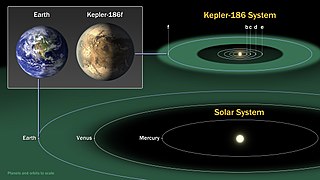Related Research Articles

A terrestrial planet, telluric planet, solid planet, or rocky planet, is a planet that is composed primarily of silicate rocks or metals. Within the Solar System, the terrestrial planets accepted by the IAU are the inner planets closest to the Sun: Mercury, Venus, Earth and Mars. Among astronomers who use the geophysical definition of a planet, two or three planetary-mass satellites – Earth's Moon, Io, and sometimes Europa – may also be considered terrestrial planets; and so may be the rocky protoplanet-asteroids Pallas and Vesta. The terms "terrestrial planet" and "telluric planet" are derived from Latin words for Earth, as these planets are, in terms of structure, Earth-like. Terrestrial planets are generally studied by geologists, astronomers, and geophysicists.

A super-Earth is an exoplanet with a mass higher than Earth's, but substantially below those of the Solar System's ice giants, Uranus and Neptune, which are 14.5 and 17 times Earth's, respectively. The term "super-Earth" refers only to the mass of the planet, and so does not imply anything about the surface conditions or habitability. The alternative term "gas dwarfs" may be more accurate for those at the higher end of the mass scale, although "mini-Neptunes" is a more common term.

Kepler-20f (also known by its Kepler Object of Interest designation KOI-070.05) is an exoplanet orbiting the Sun-like star Kepler-20, the second outermost of five such planets discovered by NASA's Kepler spacecraft. It is located approximately 929 light-years (285 parsecs, or about 8.988×1015 km) from Earth in the constellation Lyra. The exoplanet was found by using the transit method, in which the dimming effect that a planet causes as it crosses in front of its star is measured. The planet is notable as it has the closest radius to Earth known so far.

Kepler-70b is one of two postulated exoplanets orbiting the subdwarf B star (sdB) Kepler-70. The other planet is Kepler-70c, and both planets orbit very close to their host star.

Kepler-42, formerly known as KOI-961, is a red dwarf located in the constellation Cygnus and approximately 131 light years from the Sun. It has three known extrasolar planets, all of which are smaller than Earth in radius, and likely also in mass.
Kepler-47 is a binary star system in the constellation Cygnus located about 1055 parsecs away from Earth. The stars have three exoplanets, all of which orbit both stars at the same time, making this a circumbinary system. The first two planets announced are designated Kepler-47b, and Kepler-47c, and the third, later discovery is Kepler-47d. Kepler-47 is the first circumbinary multi-planet system discovered by the Kepler mission. The outermost of the planets is a gas giant orbiting within the habitable zone of the stars. Because most stars are binary, the discovery that multi-planet systems can form in such a system has impacted previous theories of planetary formation.
Kepler-80, also known as KOI-500, is a red dwarf star of the spectral type M0V. This stellar classification places Kepler-80 among the very common, cool, class M stars that are still within their main evolutionary stage, known as the main sequence. Kepler-80, like other red dwarf stars, is smaller than the Sun, and it has both radius, mass, temperatures, and luminosity lower than that of our own star. Kepler-80 is found approximately 1,223 light years from the Solar System, in the stellar constellation Cygnus, also known as the Swan.

Kepler-69c is a confirmed super-Earth extrasolar planet, likely rocky, orbiting the Sun-like star Kepler-69, the outermore of two such planets discovered by NASA's Kepler spacecraft. It is located about 2,430 light-years from Earth.
Kepler-32 is an M-type main sequence star located about 1070 light years from Earth, in the constellation of Cygnus. Discovered in January 2012 by the Kepler spacecraft, it shows a 0.58 ± 0.05 solar mass (M☉), a 0.53 ± 0.04 solar radius (R☉), and temperature of 3900.0 K, making it half the mass and radius of the Sun, two-thirds its temperature and 5% its luminosity.
Kepler-32b is an extrasolar planet in orbit around its M-dwarf-type star in the Kepler-32 system, constellation of Cygnus. Discovered by planetary transit methods with the Kepler space telescope in January 2012, it presents a semi-major axis of 0.0519 AU and temperature of 559.9 K. 2.2 Earth-radius, a mass of 4.1 MJ, and an orbital period of 5.9012 days.

Kepler-62e is a super-Earth exoplanet discovered orbiting within the habitable zone of Kepler-62, the second outermost of five such planets discovered by NASA's Kepler spacecraft. Kepler-62e is located about 990 light-years from Earth in the constellation of Lyra. The exoplanet was found using the transit method, in which the dimming effect that a planet causes as it crosses in front of its star is measured. Kepler-62e may be a terrestrial or ocean-covered planet; it lies in the inner part of its host star's habitable zone.

Kepler-69 is a G-type main-sequence star similar to the Sun in the constellation Cygnus, located about 2,430 ly (750 pc) from Earth. On April 18, 2013 it was announced that the star has two planets. Although initial estimates indicated that the terrestrial planet Kepler-69c might be within the star's habitable zone, further analysis showed that the planet very likely is interior to the habitable zone and is far more analogous to Venus than to Earth and thus completely inhospitable.
Kepler-62c is an approximately Mars-sized exoplanet discovered in orbit around the star Kepler-62, the second innermost of five discovered by NASA's Kepler spacecraft around Kepler-62. At the time of discovery it was the second-smallest exoplanet discovered and confirmed by the Kepler spacecraft, after Kepler-37b. It was found using the transit method, in which the dimming that a planet causes as it crosses in front of its star is measured. Its stellar flux is 25 ± 3 times Earth's. It is similar to Mercury.
Kepler-62d is the third innermost and the largest exoplanet discovered orbiting the star Kepler-62, with a size roughly twice the diameter of Earth. It was found using the transit method, in which the dimming that a planet causes as it crosses in front of its star is measured. Its stellar flux is 15 ± 2 times Earth's. Due to its closer orbit to its star, it is a super-Venus or, if it has a volatile composition, a hot Neptune, with an estimated equilibrium temperature of 510 K, too hot to sustain life on its surface.
Kepler-62b is the innermost and the second smallest discovered exoplanet orbiting the star Kepler-62, with a diameter roughly 30% larger than Earth. It was found using the transit method, in which the dimming effect that a planet causes as it crosses in front of its star is measured. It is likely to have an equilibrium temperature slightly higher than the surface temperature of Venus, high enough to melt some types of metal. Its stellar flux is 70 ± 9 times Earth's.

Kepler-138, also known as KOI-314, is a red dwarf located in the constellation Lyra, 219 light years from Earth. It is located within the field of vision of the Kepler spacecraft, the satellite that NASA's Kepler Mission used to detect planets transiting their stars.

Kepler-186f is an exoplanet orbiting the red dwarf Kepler-186, about 580 light-years from Earth.

Kepler-442b is a confirmed near-Earth-sized exoplanet, likely rocky, orbiting within the habitable zone of the K-type main-sequence star Kepler-442, about 1,206 light-years (370 pc) from Earth in the constellation of Lyra.

KOI-256 is a double star located in the constellation Cygnus approximately 575 light-years (176 pc) from Earth. While observations by the Kepler spacecraft suggested the system contained a gas giant exoplanet orbiting a red dwarf, later studies determined that KOI-256 was a binary system composed of the red dwarf orbiting a white dwarf.

Kepler-90i (also known by its Kepler Object of Interest designation KOI-351.08) is a super-Earth exoplanet with a radius 1.32 times that of Earth, orbiting the early G-type main sequence star Kepler-90 every 14.45 days, discovered by NASA's Kepler spacecraft. It is located about 2,840 light-years (870 parsecs, or nearly 2.4078×1016 km) from Earth in the constellation Draco. The exoplanet is the eighth in the star's multiplanetary system. As of December 2017, Kepler-90 is the star hosting the most exoplanets found. Kepler-90i was found with the transit method, in which the dimming effect that a planet causes as it crosses in front of its star is measured, and by a newly utilized computer tool, deep learning, a class of machine learning algorithms.
References
- ↑ Swift, Jonathan J. (2012). "Characterizing the Cool KOIs IV: Kepler-32 as a prototype for the formation of compact planetary systems throughout the Galaxy". The Astrophysical Journal. 764 (1): 105. arXiv: 1301.0023 . Bibcode:2013ApJ...764..105S. doi:10.1088/0004-637X/764/1/105. S2CID 43750666.
- ↑ Open Exoplanet Catalogue. "Kepler-32". Exoplanet.de. Retrieved 28 February 2013.[ permanent dead link ]


